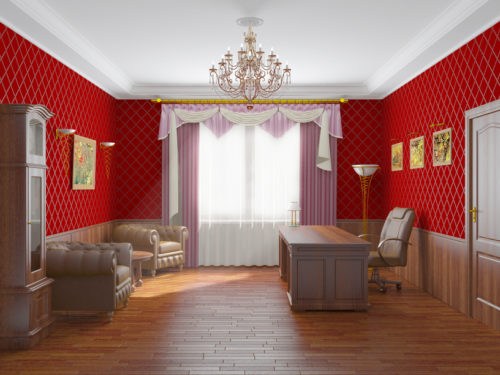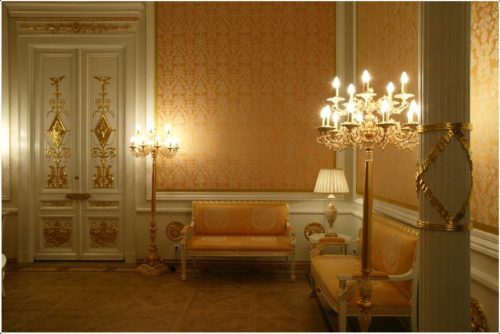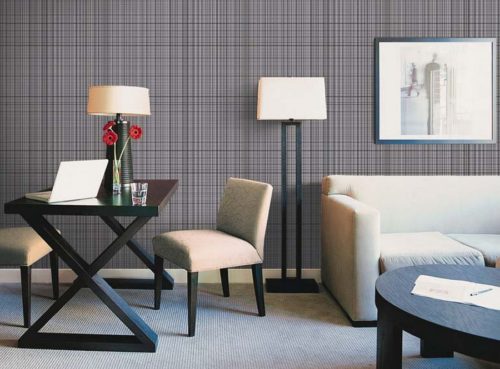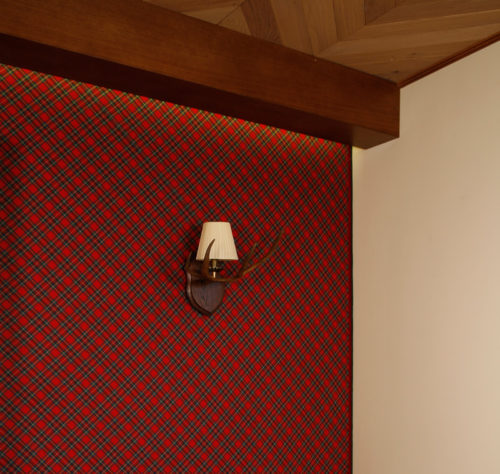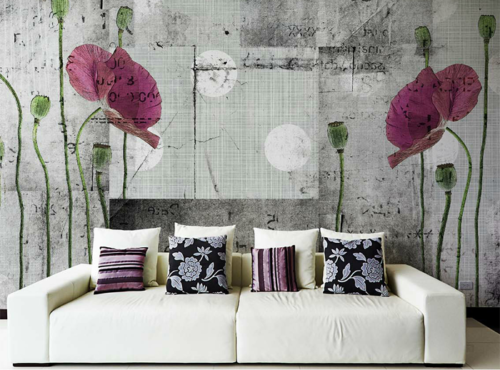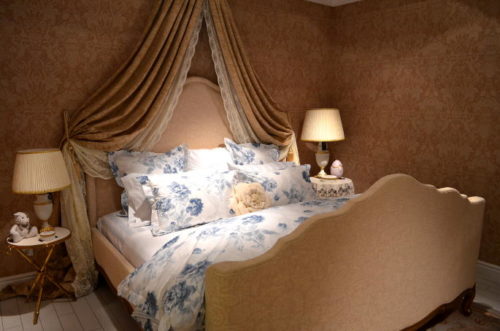The fabric on the walls is an interesting and original alternative to wallpaper, paint or panels. There are positive and negative properties with such material, as well as their installation features. We will talk about the subtleties and ways to finish the walls with cloth in this article.
Content
Use of fabric as wall finishing: advantages and complexity
The advantages of using tissue for the upholstery of the walls are as follows:
- The design of this kind looks expensive and luxurious, especially if you choose a stylish and cheap material. The finishing of the cloth is not similar to anything, and neither wallpaper, nor any other facing materials can accurately repeat the same effect.
- A room with similar design looks very cozy, the cloth perfectly smoothes all the corners and irregularities.
- Taking up the walls with a cloth, do not need to be carefully equal. This may only be needed if the material will be placed on the surface.
- Hurt the matter is quite difficult, much harder than the wallpaper. Under the action of load, the fabric just slightly stretches, but rarely rushes.
- Such material on the walls provides good sound insulation.
- The design of the room with a cloth on the walls is easy to emphasize other interior objects: furniture, pillows, curtains, any textile. Vehicle options for the upholstery of the walls are sold a lot.
If we talk about the difficulties of using fabric on the walls instead of wallpaper, it is worth highlighting the following:
- Many types of fabric absorb dust well, but it is quite difficult to get rid of it. There are also such matter that pushes dirt, but they are more expensive than simpler counterparts.
- Textiles on the walls does not deteriate damage, but the external attraction loses the faster than the other types of finishes. They contribute to the dust and various contaminants that change the color of the material make it dim, remain on the walls in the form of spots and often do not rub off.
Choose a cloth for walls
If you decorate the wall with a tissue, it is important to choose the material not only beautiful, but also suitable for operational characteristics. From the point of view of design there are no restrictions, the appearance of the finish is chosen taking into account the personal preferences of the owner, but the fabric properties are important:
- It should not be too stretched, but it must have a certain elasticity, so as not to rush under mechanical impacts. The matter of increased extensibility through time saves, from which the appearance of the finish is greatly spoiled.
- The strength of the material is also important. It is known that thin tissues are lighter than dense.
- For the decoration of the premises, natural one hundred percent flax and cotton are not suitable. They are not too durable and quickly fade into the sun. It is better if the textiles will have a mixed composition or completely consisting of synthetics.
- From natural fabrics for cladding walls, Jute, Jacquard or Sizal is considered optimal. Suitable artificial and synthetic variants are viscose, polyester, polyacryl and polyamide.
Under the operational characteristics, synthetic matter exceeds natural analogues, since they are more durable, dust are worse, they are not so faded from ultraviolet, not accumulating static electricity. But artificial fabrics do not breathe - only natural textiles can provide such an effect. Perfect option - Mixed Materials.
For the upholstery of the walls, it is good to use fabrics that have passed special processing in order to improve performance. It is not bad for finishing furniture fabrics, because they are strong enough. As for drawing and colors, they should not annoy and tire who will dwell in the room.
Scope of use of tissue wall decoration
Fabric as a wall upholstery is suitable only for certain rooms. We will deal with more details with the area of \u200b\u200bits application:
- Similarly, it is best to decorate the walls in bedrooms, cabinets or living rooms.
- Do not use such a finish in the kitchens, hallways or children's rooms. There the walls are dirty much more often, and you can not always wash the contamination. In the kitchens, the matter is not only contaminated, but also absorbs odors of food. Subsequently, the indoors will constantly felt the smell of old fat.
- Walls, upholstered with fabric material, are very often found in restaurants and cafes. It should be noted that such a design looks fashionable and stylish there.
- In the bedrooms, with the aim of improving sound insulation, you can cut the walls with jacquard fabrics or textiles on the substrate.
- In those rooms where humidity is raised, there is no place for natural matters, and you can only use the synthetic. Moreover, after the tissue upholstery, it is advisable to impregnate with a special water repellent solution.
- Walls can be fermented with seamless fabrics, which are used for stretch ceilings. This is a reliable and durable option, the disadvantage of which is only a high cost.
Manufacturers of finishing fabrics for walls
Walls can be issued with almost any cloth, but there are materials, especially for this purpose. They produce various firms with which we invite you to familiarize yourself:
- Bekaert Textiles - Firm of Belgian origin, which produces durable and dense materials. In its product, it uses a teflon coating that makes it well and moisture, and mechanical impacts. The company positions its goods as waterproof and declares that textiles is suitable even for decorating bathrooms.
- The product of the Swiss company Creation Baumann has an increased strength and a rich assortment of shades. Among the options you can even find matter with the effect of the night sky.
- Sangiorgio of Italian origin specializes in the release of jacquard fabrics. The company has existed over 40 years, and during this time the quality of its products did not deteriorate. In addition, the firm constantly expands the range of his product.
- French brand Lesura produces various types of fabrics for walls. The basis of the materials are viscose, cotton, polyester. Its fabrics are sold in wide large rolls of 2.6-2.9 m, so that often the coating can be applied seamlessly. The company's entire product has an anti-free coating, does not fade in the sun. Lesura gives a 10-year warranty on its product.
- Clara Lander is a popular world-wide French textile manufacturer, which offers an incredibly wide range of goods for every taste. The company's products are characterized by high quality, waterproof, bactericidal, anti-flaps and antistatic properties. The fabric of this brand is easily cleaned with spots, besides, there are even matter with flame retardant qualities in the assortment.
- Belgian firm Bruvatex produces cotton and viscose products. Her goods have a long service life, resistant to ultraviolet and static electricity. Fastened textiles on the wall using profiles. Products are distinguished by a good range, in the case of contaminants, the stains are easily rubbed, if you do not leave them for a long time.
It is best for facing the walls to buy materials that are specifically designed for this. High-quality textiles will last longer and will always look attractive.
Finishing wall cloth with your own hands
Preparatory stage
Preparation for finishing wall cloth does not take much time if you do not intend to attach textiles on glue, like wallpaper. There is no need to level the surface, but some preparation recommendations still exist:
- It is advisable to clean the wall before the upholstery, so that it does not absorb into matter from the inside. For a start, walk on the workforce with a vacuum cleaner, then wipe with a damp cloth using any detergent. This Council is relevant for stone walls.
- The base from the drywall is impossible to wash. It can be wiped with a dry sponge, well, if there are significant contaminants, they can be sharpened or attached. If in the room is increased humidity, plasterboard can be painted with water-repellent composition.
- If the rust stains appear on the wall, such zones need to be treated with a tissue with a tissue, and then go to wallpaper.
Talking fabric on the wall
The easiest way to fasten the cloth from the fabric on the wall is to pull it. To perform this process, you need the following:
- self-tapping screws and dowel;
- wooden rails;
- pencil;
- screwdriver;
- building level;
- roulette.
This is how textile pulling on the wall is performed:
- The working base is set to a plank of wood. To do this, first with a roulette measuring the number of centimeters between the floor and the ceiling and make a pencil mark. Planet mounting line for convenience is better to draw throughout the room.
- Along the marking on the wall, rains are installed. They are fixed under the ceiling and above the floor. Self-tapping screws are taken for drywall bases, and in concrete, brick or stone twisted the dowels. It is very important to observe the same distance between the planks and fix them strictly in parallel, otherwise the fabric will go folds and wrinkles, and the drawing will not be smooth.
- Plugging the rails, between them stretch the canvas and fix it with decorative nails. Then nails can be hidden under plinths. For installation, the fabric is first attached to the upper rail and pull in width, gradually fixing on the bottom rake and tracking, so that the wrinkles are not formed.
- Since the rake has a certain thickness, a free space remains between matter and the wall, which is suitable for mounting the insulation. Felt, polyurethane foam, foam or mineral wool thick thickness can be used as a thermal insulating layer.
- If you have made a decision on the insulation of the wall, do it, of course, it should be tightly tightly. The insulation is fixed on the base with the help of glue, which is lubricated both the wall itself and the heat-insulating material. The glue should be applied carefully and carefully, so that even the small amounts did not come out and do not impregnate the fabric. If the glue still fascinated through the insulation, it can be hidden using the finishing tape, sinking the joints between the sheets. Note that the color of the insulation was not darker than the color of the fabric.
Sticking the Wall Cloths
The fabric on the wall can not only stretch, but also stick. This will require careful preliminary preparation of the working foundation. You can align the wall in two main ways:
- Installation of plasterboard sheets. This process is carried out relatively quickly, and after work there is a minimum number of construction debris. Plasterboard allows you to achieve a practically perfectly smooth condition of the walls, the only places where you have to apply putty - it is at the junctions between the sheets and in the location zones of fasteners.
- Apply plaster. This is a longer and time-consuming process, providing for repeated plastering, grinding and surface shtcloth. After work, as a rule, a lot of dust and garbage remains, and the result is worse than the expected if the master does not have sufficient experience.
For the installation of matter, the wall will have to use a partner, because it is very difficult to cope with such a task alone. It will take the following to work:
- stationery knife or well sharpened small kitchen knife;
- heavy Iron;
- furniture glue dried under the action of a hot iron;
- metal line of 1 m long.
Work on the wamp of wall cloth includes such actions:
- Since furnace can dry only at a high temperature, it can be immediately applied to the entire area of \u200b\u200bthe working surface.
- Fasting the walls, tissue canvas are glued to them. For this, the fabric is stretched in the direction from the ceiling to the floor, and to begin with the upper corner of the segment attached to the wall with a small carnation.
- The canvas smooth over the surface with a heavy hot iron, so that there were no folds and bubbles. Iron also work on top down, in the process of smoothing the adhesive is absorbed into the offside of the fabric and freezes.
- So that wrinkles did not appear on the fabric, the second person should keep it on top and not allow to shift. Working alone, the material must be topped with cloves around the perimeter.
- When the cloth is pasted completely, the excess it is cut off with a sharp knife. At the joints of the segments, as well as near the floor and the ceiling, you need to apply more glue, so that the fabric is not dissolved there.
- So that the furnace is fully frozen, he needs 3 days.
Drapery wall cloth
The drape of the walls is considered the most difficult in performing the way to decorate the room. The area of \u200b\u200bthe material used in this case exceeds the area of \u200b\u200bthe room, and the process will need a partner. That's what you need to dramatize the walls:
- fabric canvas;
- a pencil ruler;
- wooden rails;
- building level;
- roulette;
- nails and self-tapping screws with decorative hats;
- electrolovik;
- screwdriver.
Drape the walls in this way:
- Initially, you need to measure the height of the walls to the level where drapery will begin.
- The height of the drapery is stuck with a pencil around the perimeter of the room.
- Then the fabric is taken, the corner is fixed at the top on the marked line of a small carnation. In the same way, the entire top edge of the canvase is attached to the wall.
- Wooden rail is mounted on top of the fabric and is screwed to the working base with self-draws. The space between the fasteners should be 20-30 cm.
- The lower edge of the canvase is fixed in the same way. In the process of operation, the fabric can be both fully stretched and form decorative folds. This technology is different from the first method by the fact that the rake is nailed over the tissue.
- To the edges of the canvas looked beautiful and neatly, the cloth must be cut off exactly, adding 2 cm to the measured height of 2 cm. Extra centimeters in the installation process are seized and hidden under the rail.


